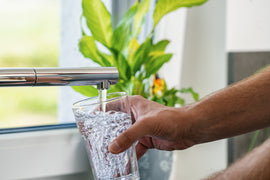Plastic pollution is a global problem, and the solution starts at home. Research shared by National Geographic says the U.S. is the world’s largest generator of plastic waste, producing nearly 42 million metric tons in 2016, with less than 10 percent of plastic waste recycled.
These numbers may seem overwhelming, but fortunately learning how to reduce pollution in your own household is a more manageable concept to embrace. If everyone does their individual share, it will have a greater collective impact. Ways to reduce plastic waste include recycling, supporting a plastic bag tax or ban, using reusable bags, eliminating the use of plastic straws, and being environmentally-conscious about the brands you favor.
You can also become more engaged within your community through neighborhood clean-ups and other plastic-free initiatives. The best news is that you can get started with any or all of these best practices today.
Reduce, Reuse, Recycle
Reduce, reuse, recycle has been an eco-friendly mantra for years. It encourages everyone to do their part in reducing plastic pollution. When following ways for how to reduce pollution, an easy way to get started is simply limiting the amount of plastic you buy. When shopping online, choose to ship everything together to reduce the amount of plastic packaging needed to receive your goods. Opt for washable items over one-time plastic plates and utensils that’ll have to be disposed of right away or use disposal items made of purely biodegradable materials.
Next, reuse items as much as possible, such as repurposing plastic containers for other household activities like gardening or storage. Even if you can’t do this with all the plastic found in your home, being purposeful with items you can reuse helps reduce the amount of pollution you contribute to the environment on a regular basis.
Finally, recycle. Check with your housing management office or city trash services regarding at-home recycling bins and designated recycling centers where you can take your plastic. Make it easy for yourself and your family to recycle without taking any extra steps of having to sort through the garbage later. Set up a separate bin in your home that’s meant solely for plastic recyclables.
Note how much you save on a weekly basis by setting aside your recyclables. It’ll give you greater insight into how much plastic your family uses. You may be surprised how much waste adds up.
Support State Single-Use Plastics Tax or Ban
Depending on where you live, you may have the opportunity to vote on an initiative to eliminate single-use plastics that would place a tax or ban on their use statewide. In 2014, California became the first state to impose a statewide ban on single-use plastic bags at large retail stores, with a 10-cent minimum charge for paper bags or reusable plastic bags at certain locations.
Hawaii, New York, Connecticut, Delaware, Maine, Oregon, and Vermont also have legislation in place to restrict the usage of single-use plastics to demonstrate how to reduce pollution in their own states. Several others have followed suit imposing their own legislation to reduce the amount of plastic pollution in their respective states.
It reduces plastic bag use but still allows for reusable bags or paper options in stores to bag groceries or supplies. The convenience remains without the extra burden on the environment through plastic waste.
Use Reusable Bags When Shopping
Following legislation banning single-use plastic bags and/or adding a charge to reusable bags bought in stores, many people have turned to taking their own reusable bags shopping. This cuts down on costs in personal money management and motivates the masses to reach for an alternative solution.
Often when bagging groceries, more plastic bags are used than necessary and some items may require a thicker carrier causing baggers to double up. Canvas totes do the trick, can hold heavier weights, and reduce the need for unnecessary single-use plastic bags that make their way to your home and may or may not get recycled or reused.
Using your own reusable bags reduces plastic pollution and the supply of plastic bags needed by stores. At the same time, it maintains convenience for shoppers. Many keep their bags in the trunk of their cars to buy groceries, use at farmers markets, or anywhere where a bag may be necessary. It’s practical and supports a large push for reducing plastic pollution.
Eliminate Use of Plastic Straws
In addition to the ban on plastic bags, many states have begun to eliminate use of plastic straws or make them available only upon request. Paper or metallic replacements have become more in demand toward the goal of plastic pollution control. Though there’s not likely a need for plastic straw use at home, if you prefer drinking water out of one, choose a reusable straw for your drinks. They are easily washable and can be used for years.
Take them with you when traveling, camping, or anywhere where you may want to use a straw. The more habitual you make carrying reusable totes, water bottles, and even straws, the more it’ll become second nature for you and your family wherever you go.
Stop Buying Plastic Water Bottles
Plastic water bottles used to be the main way for people to conveniently and somewhat inexpensively get filtered water. However, with alternatives like at-home water filtration systems and public purified water quality refill stations, the need for plastic water bottles is becoming obsolete. Relying on these options helps to greatly reduce the amount of plastic pollution.
The majority of plastic water bottles aren’t recycled. Instead, they overrun landfills and spill off into the ocean, disrupting the marine ecosystem. Also, many bottled water brands have admitted that what they’re selling is actually tap water. It’s not sourced, and some of it’s not treated any differently, than what comes out of your own faucet drinking water. Furthermore, investing in at-home systems, such as the FloFaucet, you’ll save $700 a month compared to buying bottled water while guaranteeing the removal of up to 99 percent of contaminants and pollutants found in water. Pharmaceuticals in water have been detected in groundwater supplies across the country so getting purified water has become even more necessary in recent years.
By using your own reusable water containers, you can take them with you wherever you go. As with single-use plastic bags and plastic straws, plastic water bottles are banned in some cities and airports. Plus, old water fountains and outdated public water stations are being upgraded with purified water refill stations like FloWater. These are found in gyms, airports, hotels, and other public spaces, making it possible for you to get purified water quality on-the-go.
FloWater dispenses crisp, clean, chilled water on-demand. With a one-touch refill button and speedy dispensing, it supplies water for a large capacity without drawing a crowd. As public spaces continue to reduce the availability of single-use plastic, it’s all the more advantageous for you to make the switch to relying on reusable water bottles.
Choose Sustainable Brands
Learning how to prevent pollution also involves reading brand labels. Brands are becoming increasingly conscientious about their environmental impact and waste management when it comes to plastics, which makes it easier to choose sustainable brands that focus on using biodegradable materials and limit plastic in their packaging. For the sake of transparency, many brands list sustainability as a company value on their website and will share the insights of how much they save on plastic pollution or give back to the environment every year.
Learn more about how your favorite brands create and package their goods. A majority of plastic pollution comes from how items are packaged for shipping. By choosing to receive all of your items in one shipment or buying in bulk, this helps to cut down on how much plastic you use at home. As you decide which brands you buy from, source ones that actively reduce their own carbon footprints.
Volunteer for a Neighborhood Clean Up
An engaging activity for how to prevent pollution is a neighborhood clean up. Check your community for local beach or park opportunities. Do this as a family or invite your work team to join you as you help clean up plastic pollution (and other litter) from your area.
It’s a way to invest your time back into where you live and usually takes only a few hours a month. Working in a collaborative clean up effort can do a lot to limit pollutants from reaching water sources or keep your neighborhood clean.
Start Plastic-Free Initiatives at Work
Once you’ve created the habit of how to reduce pollution at home, share your ideas at work to reduce your company’s level of plastic use as well. This expands the reach of people who will become more conscientious about their recycling efforts and will think twice before purchasing bottled water for the office. With so many easy, free pollution prevention solutions in place, it’s an easy sell to those in charge of making decisions.
Make it your at-home mission to effectively reduce plastic pollution in as many ways as possible. Start with setting up a separate recycling bin for plastics and using canvas totes instead of single-use plastic bags. Add on to these daily habits by researching the brands you use and encouraging others to support plastic-free lifestyles as well. The more people take active steps to reduce plastic pollution, the better it will be for all.
Sources:
https://www.nationalgeographic.com/environment/2020/10/us-plastic-pollution/
https://www.ncsl.org/research/environment-and-natural-resources/plastic-bag-legislation.aspx





